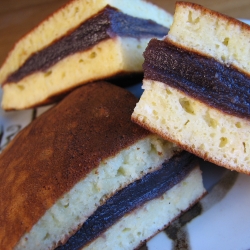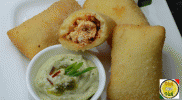
It is a south Indian Dahi vada (lentil dumplings) is a popular Indian chaat, prepared by ...

Be ready to surprise your kids with this amazingly delicious homemade pizza recipe...
Cheese stuffed onion pakoda is extremely a creative snack made with a mix of chickpea flo...

A combination of paneer, sweet corn, and capsicum in this pizza pockets. Paneer pizza po...
Paratha is a popular breakfast bread from Punjab. 3 layered curd paratha reduce the amoun...

Rajasthani meal is incomplete without the mention of the well known Dal-Baati-Churma. Mad...
This traditional Japanese confection is made of two small sweet pancakes wrapped around sweet red bean paste filling.
Japanese cuisine has evolved via centuries of social and economic modifications, and includes the regional and conventional foods of Japan. The standard delicacies of Japan are dependent on rice with miso soup along with other recipes, with a focus on seasonal ingredients.
The conventional Japanese meal includes rice (gohan), miso soup (miso shiru), pickled veggies (tsukemono) and fish or meat. Whilst rice is the staple... Read More..
|
About Recipe
|
|||||||||||||||||||||||||||
|
|||||||||||||||||||||||||||
Japanese cuisine has evolved via centuries of social and economic modifications, and includes the regional and conventional foods of Japan. The standard delicacies of Japan are dependent on rice with miso soup along with other recipes, with a focus on seasonal ingredients.
The conventional Japanese meal includes rice (gohan), miso soup (miso shiru), pickled veggies (tsukemono) and fish or meat. Whilst rice is the staple food, various kinds of noodles (udon, soba and ramen) are low-cost and incredibly preferred for light meals.
Being an island nation, the Japanese take fantastic pleasure for their seafood. Fish is typical, generally barbequed, but additionally offered uncooked as sashimi or even in sushi. Seafood and veggies also are deep-fried in the mild batter as tempura.
Japan possesses a local type of desserts called wagashi consist of ingredients including red bean paste and also indigenous rice wine or shake. Numerous modern day desserts and sweets in Japan are also available.
Japanese delicacies consist of various cooking practices of Japan. Every area in Japan possesses its own traditions about cooking. Meals consumed in Japan also reflect the story of the cultural exchange among Japan along with other culture. Because the present times, the impact of the West influenced Japanese cooking traditions to create new recipes, many of which have grown to be preferred not merely within Japan but also outside. Nevertheless, the majority of the cooking practices of Japan generally believe that seasonality is essential.
Japanese delicacies have recently turn out to be a lot more recognizable and valued all over the world.
 Easy recipes
Easy recipes
 Healthy Recipes
Healthy Recipes
 Dessert Recipes
Dessert Recipes
 Mutton and Lamb
Mutton and Lamb  Indian Bread Recipes
Indian Bread Recipes
 Dal Recipes
Dal Recipes
 Chutney and Pickles
Chutney and Pickles  Indo-Chinese Recipes
Indo-Chinese Recipes
 Snacks and Appetizers
Snacks and Appetizers
 Low Fat Recipes
Low Fat Recipes
 Chaat Recipes
Chaat Recipes
 Biryani and Rice
Biryani and Rice  Curry Recipes
Curry Recipes
 Indian Sweet Recipes
Indian Sweet Recipes
 Egg Recipes
Egg Recipes
 Paneer Recipes
Paneer Recipes
 Chicken Recipes
Chicken Recipes
 Indian tiffins
Indian tiffins
 Egg less Recipes
Egg less Recipes
 Soups and Salads
Soups and Salads
 Indian Sea Food
Indian Sea Food
 Manchurian Recipes
Manchurian Recipes
 Indian Drinks Recipes
Indian Drinks Recipes
 Dinner Recipes
Dinner Recipes